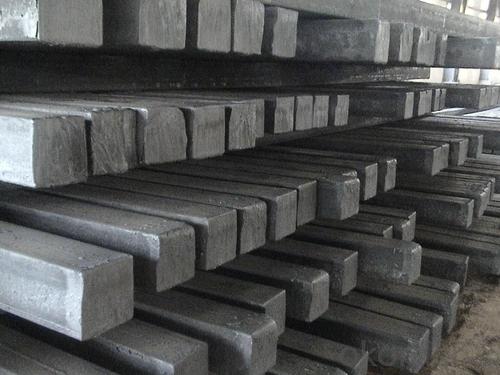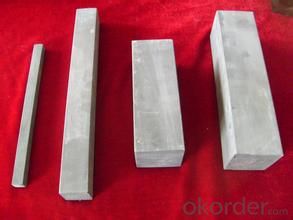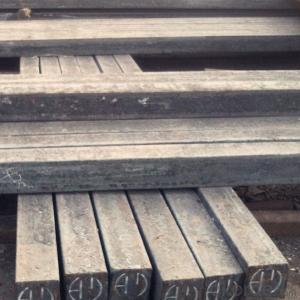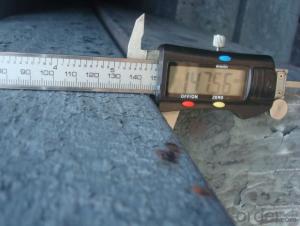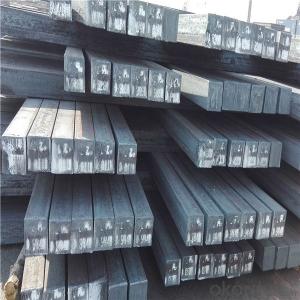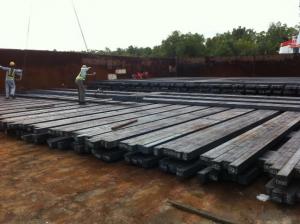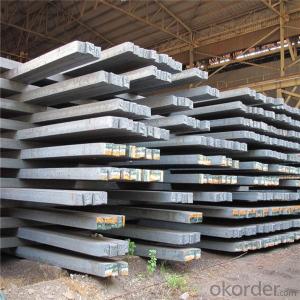Square Steel Billet 150mm
- Loading Port:
- China Main Port
- Payment Terms:
- TT or LC
- Min Order Qty:
- -
- Supply Capability:
- -
OKorder Service Pledge
OKorder Financial Service
You Might Also Like
Product Description:
OKorder is offering Square Steel Billet 150mm at great prices with worldwide shipping. Our supplier is a world-class manufacturer of steel, with our products utilized the world over. OKorder annually supplies products to European, North American and Asian markets. We provide quotations within 24 hours of receiving an inquiry and guarantee competitive prices.
Product Applications:
Square Steel Billet 150mmare ideal for structural applications and are widely used in the construction of buildings and bridges, and the manufacturing, petrochemical, and transportation industries.
Product Advantages:
OKorder's Square Steel Billet 150mm are durable, strong, and resist corrosion.
Main Product Features:
· Premium quality
· Prompt delivery & seaworthy packing (30 days after receiving deposit)
· Corrosion resistance
· Can be recycled and reused
· Mill test certification
· Professional Service
· Competitive pricing
Product Specifications:
Manufacture: Hot rolled
Grade: Q195 – 235
Certificates: ISO, SGS, BV, CIQ
Length: 6m – 12m, as per customer request
Packaging: Export packing, nude packing, bundled
Chinese Standard (H*W*T) | Weight (Kg/m) | 6m (pcs/ton) | Light I (H*W*T) | Weight (Kg/m) | 6m (pcs/ton) | Light II (H*W*T) | Weight (Kg/m) | 6M |
100*68*4.5 | 11.261 | 14.8 | 100*66*4.3 | 10.13 | 16.4 | 100*64*4 | 8.45 | 19.7 |
120*74*5.0 | 13.987 | 11.9 | 120*72*4.8 | 12.59 | 13.2 | 120*70*4.5 | 10.49 | 15.8 |
140*80*5.5 | 16.89 | 9.8 | 140*78*5.3 | 15.2 | 10.9 | 140*76*5 | 12.67 | 13.1 |
160*88*6 | 20.513 | 8.1 | 160*86*5.8 | 18.46 | 9 | 160*84*5.5 | 15.38 | 10.8 |
180*94*6.5 | 24.143 | 6.9 | 180*92*6.3 | 21.73 | 7.6 | 180*90*6 | 18.11 | 9.2 |
200*100*7 | 27.929 | 5.9 | 200*98*6.8 | 25.14 | 6.6 | 200*96*6.5 | 20.95 | 7.9 |
220*110*7.5 | 33.07 | 5 | 220*108*7.3 | 29.76 | 5.6 | 220*106*7 | 24.8 | 6.7 |
250*116*8 | 38.105 | 4.3 | 250*114*7.8 | 34.29 | 4.8 | 250*112*7.5 | 28.58 | 5.8 |
280*122*8.5 | 43.492 | 3.8 | 280*120*8.2 | 39.14 | 4.2 | 280*120*8 | 36.97 | 4.5 |
300*126*9 | 48.084 | 3.4 | 300*124*9.2 | 43.28 | 3.8 | 300*124*8.5 | 40.87 | 4 |
320*130*9.5 | 52.717 | 3.1 | 320*127*9.2 | 48.5 | 3.4 | |||
360*136*10 | 60.037 | 2.7 | 360*132*9.5 | 55.23 | 3 |
FAQ:
Q1: Why buy Materials & Equipment from OKorder.com?
A1: All products offered byOKorder.com are carefully selected from China's most reliable manufacturing enterprises. Through its ISO certifications, OKorder.com adheres to the highest standards and a commitment to supply chain safety and customer satisfaction.
Q2: How do we guarantee the quality of our products?
A2: We have established an advanced quality management system which conducts strict quality tests at every step, from raw materials to the final product. At the same time, we provide extensive follow-up service assurances as required.
Q3: How soon can we receive the product after purchase?
A3: Within three days of placing an order, we will begin production. The specific shipping date is dependent upon international and government factors, but is typically 7 to 10 workdays.
Q4: What makes stainless steel stainless?
A4: Stainless steel must contain at least 10.5 % chromium. It is this element that reacts with the oxygen in the air to form a complex chrome-oxide surface layer that is invisible but strong enough to prevent further oxygen from "staining" (rusting) the surface. Higher levels of chromium and the addition of other alloying elements such as nickel and molybdenum enhance this surface layer and improve the corrosion resistance of the stainless material.
Q5: Can stainless steel rust?
A5: Stainless does not "rust" as you think of regular steel rusting with a red oxide on the surface that flakes off. If you see red rust it is probably due to some iron particles that have contaminated the surface of the stainless steel and it is these iron particles that are rusting. Look at the source of the rusting and see if you can remove it from the surface.
Images:
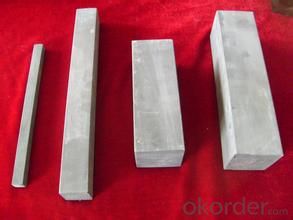

- Q: What is the role of steel billets in the construction of power plants?
- Steel billets play a crucial role in the construction of power plants. These billets are semi-finished steel products that are used as raw material in various processes, including the fabrication of structural components and equipment for power plants. One of the primary applications of steel billets in power plant construction is in the production of structural steel. Structural steel is used to build the framework of power plant structures, such as the main building, turbine halls, reactor buildings, and cooling towers. Steel billets are melted, refined, and cast into various shapes and sizes to create the necessary structural components, including beams, columns, and trusses. These components provide the necessary support and stability to the power plant infrastructure. Additionally, steel billets are also used in the manufacturing of equipment and machinery required for power generation. For instance, they are used to produce turbine rotors, generator frames, and condensers. These components are essential for the operation of power plants and contribute to the efficient conversion of energy. Moreover, steel billets are utilized in the construction of storage tanks, pipelines, and ducts within power plants. These structures are necessary for the storage and transportation of various fluids, such as water, steam, and fuel. Steel billets are transformed into sheets, plates, and tubes to fabricate these components, which are designed to withstand high pressures and temperatures. Furthermore, steel billets are highly durable and possess excellent mechanical properties, such as strength and toughness. These properties make them suitable for withstanding the harsh operating conditions and loads experienced in power plants. They can withstand high temperatures, corrosion, and stresses, ensuring the structural integrity and longevity of power plant infrastructure. In summary, steel billets are essential in the construction of power plants as they are used to produce structural components, equipment, and machinery. Their durability, strength, and versatility make them a preferred material in this industry. The use of steel billets ensures the reliability and safety of power plants, contributing to the generation of electricity for various industries and communities.
- Q: How are steel billets used in the manufacturing of furniture and fixtures?
- Steel billets are used in the manufacturing of furniture and fixtures as they serve as the raw material for various components. These billets are shaped, cut, and molded to create the desired parts and structures, such as frames, legs, and supports. The high strength and durability of steel make it a popular choice for furniture and fixture manufacturing, ensuring long-lasting and sturdy products.
- Q: What are the disadvantages of using steel billets?
- Some potential disadvantages of using steel billets include their high cost, the need for specialized equipment and processes to handle and shape them, and their relatively limited availability compared to other forms of steel. Additionally, steel billets can be susceptible to defects such as cracking or porosity, which may require additional quality control measures.
- Q: How are steel billets used in the production of transmission towers?
- Transmission towers require steel billets, which are semi-finished steel products, as a crucial component for their production. The first step in the process is to heat the steel billets in a furnace at extremely high temperatures. This hot rolling process softens the billets and makes them more malleable, enabling easy shaping and forming into the desired structure of the transmission tower. Once heated, the billets are then passed through rolling mills, where they are shaped into long, cylindrical sections known as steel bars. These bars are further processed and cut to the required length and dimensions based on the specific design and requirements of the transmission tower. Following the shaping and cutting, the steel bars undergo galvanization, which involves coating them with a protective layer of zinc. This zinc coating provides corrosion resistance, safeguarding the tower from environmental elements like moisture and rust. Finally, the galvanized steel bars are assembled and welded together to create the intricate framework of the transmission tower. The usage of strong and durable steel billets ensures that the tower can withstand heavy loads and extreme weather conditions. In conclusion, steel billets are essential for the production of transmission towers due to their strength, flexibility, and corrosion resistance. Their ability to be shaped and formed into the desired dimensions, along with their durability, make them an ideal material for constructing transmission towers.
- Q: What is the role of steel billets in the construction industry?
- Steel billets play a crucial role in the construction industry as they serve as the raw material for manufacturing various steel products. These solid, semi-finished forms of steel are typically used in the production of beams, bars, rods, and other structural components. By providing strength, durability, and flexibility to structures, steel billets contribute significantly to the overall integrity and safety of buildings, bridges, and other infrastructure projects.
- Q: How are steel billets used in the production of building facades?
- Steel billets are used in the production of building facades as they serve as the raw material for manufacturing different components such as beams, columns, and plates. These billets are hot-rolled or forged into specific shapes and sizes, which are then used to create the structural framework of the facade. Additionally, steel billets are also used to create decorative elements and cladding panels that enhance the aesthetic appeal of the building exterior.
- Q: How are steel billets used in the manufacturing of marine components?
- Due to their strength, durability, and versatility, steel billets are indispensable raw materials utilized in the production of marine components. Essentially, steel billets are semi-finished steel products that are cast into specific shapes, typically squares or rectangles, via continuous casting. These billets serve as the initial stage for a variety of marine components. Hot rolling is a primary method employed in the manufacturing of marine components using steel billets. In this process, the steel billet is heated to high temperatures and then passed through a series of rollers to shape it into the desired form. This can involve transforming the billet into rods, bars, beams, or other structural shapes commonly utilized in marine applications. Forging is another technique employed in the manufacturing of marine components using steel billets. This process involves heating the billet to high temperatures and subsequently applying pressure to shape it into the desired form. Forging is commonly employed to manufacture marine components such as propeller shafts, crankshafts, and other high-strength parts that necessitate precise shaping and exceptional mechanical properties. Furthermore, steel billets can be utilized in the manufacturing of marine components through the process of machining. Machining entails the removal of material from the billet using various cutting tools to create intricate shapes and features. This method is commonly employed to produce marine components such as valves, fittings, and other precision parts that require meticulous tolerances and intricate designs. In conclusion, steel billets play a pivotal role in the manufacturing of marine components. Their strength, durability, and versatility make them an ideal raw material for producing various marine parts through processes such as hot rolling, forging, and machining. By utilizing steel billets, manufacturers can ensure that the marine components they produce are capable of withstanding the harsh conditions and demanding requirements of the marine environment.
- Q: What are the different types of steel billet cutting defects?
- There are several different types of steel billet cutting defects that can occur during the cutting process. These defects can have varying degrees of severity and can impact the quality and integrity of the final product. Some common types of steel billet cutting defects include: 1. Burr formation: Burrs are small, unwanted pieces of metal that are left behind on the edges of the cut. They can be caused by factors such as improper cutting blade alignment, excessive cutting speed, or worn-out cutting blades. Burrs can affect the dimensional accuracy of the billet and may require additional processing to remove. 2. Cracks: Cracks can occur during the cutting process due to the high stress and heat generated. They can result from factors such as improper cutting speed, inadequate cooling, or material inconsistencies. Cracks can compromise the structural integrity of the billet and can lead to failure in the final product. 3. Surface imperfections: Surface imperfections can include scratches, dents, or gouges on the surface of the billet. These defects can be caused by factors such as improper handling, inadequate lubrication, or worn-out cutting blades. Surface imperfections can affect the appearance of the final product and may require additional processing to rectify. 4. Incorrect dimensions: Cutting defects can also manifest as deviations from the desired dimensions of the billet. These deviations can arise from factors such as improper cutting blade alignment, inaccurate measurements, or machine malfunctions. Incorrect dimensions can result in compatibility issues during subsequent processing steps or in the final product. 5. Slag inclusion: Slag is a byproduct that can be present in the steel billet. During the cutting process, if the cutting blade encounters slag, it can become embedded in the cut edge. Slag inclusion can lead to structural weakness and reduced mechanical properties in the final product. It is essential to identify and rectify these cutting defects to ensure the production of high-quality steel billets. Regular maintenance and inspection of cutting equipment, proper training of operators, and adherence to quality control measures can help minimize these defects and ensure the production of defect-free steel billets.
- Q: What is the role of steel billets in the manufacturing of automotive body panels?
- The manufacturing of automotive body panels heavily relies on steel billets, which are essential semi-finished metal products. These billets serve as the initial material for creating various components that compose a car's body. The primary rationale behind using steel billets in this process lies in their exceptional strength and durability. Automotive body panels need to endure different external forces and impacts, such as collisions, extreme weather conditions, and everyday wear and tear. Steel, being a robust and inflexible material, provides the necessary structural integrity to ensure the vehicle's safety and longevity. Furthermore, steel billets offer versatility in terms of design and customization. They can be effortlessly molded and shaped into different forms and sizes, enabling manufacturers to produce body panels with precise specifications. This adaptability allows for the creation of diverse car models with unique designs that meet the varied demands of consumers. Additionally, steel billets are favored for their cost-effectiveness. Steel is a widely available and relatively inexpensive material, making it a practical option for large-scale production. Moreover, its recyclability further reduces production costs and lessens environmental impact. In conclusion, the role of steel billets in the manufacturing of automotive body panels is of utmost importance. They provide the necessary strength, durability, versatility, and cost-effectiveness required for producing high-quality and dependable car bodies.
- Q: What are the weight ranges of steel billets?
- The weight of steel billets can vary based on the industry's specific requirements and standards. Generally, steel billets can weigh anywhere from a few kilograms to several metric tons. The weight of a steel billet is determined by factors like its dimensions, intended application, and production process. Smaller steel billets, used in construction or manufacturing, typically weigh between 1 to 10 kilograms. Conversely, larger steel billets, commonly utilized in heavy machinery or infrastructure projects, can weigh anywhere from 10 to 100 metric tons or potentially more. It is important to note that these weight ranges are approximate estimates and may differ depending on the particular industry requirements and production capabilities.
Send your message to us
Square Steel Billet 150mm
- Loading Port:
- China Main Port
- Payment Terms:
- TT or LC
- Min Order Qty:
- -
- Supply Capability:
- -
OKorder Service Pledge
OKorder Financial Service
Similar products
Hot products
Hot Searches
Related keywords


